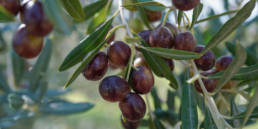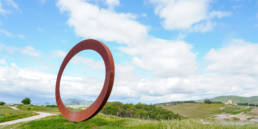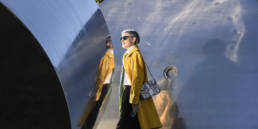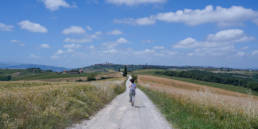The chances of finding a really special restaurant in Italy are pretty good, though it doesn’t happen every day. But what are the chances of stumbling upon a place in Maremma run by art historians?

Pitigliano, a hill town in Maremma, is known for its unusual tufa structure, being built right out of this soft rock, and its Jewish history, with a museum and synagogue. On a warm fall Saturday we visited the town with an eye more to getting a feel of the place than to its history – also because, of course, the Jewish museum is closed on Saturdays. It’s a town that is most often photographed from afar, and today was no exception – we parked before entering the town in order to view the earth-coloured stone down contrasting with the conveniently blue sky and its cute clouds.

In the town itself, we admired the Renaissance palazzo and its square flanked by Baroque fountains and architectonic frames for the landscape.

But we had one major goal in mind before we were to head to the nearby via Cave for a long walk on this impressive Etruscan road: lunch. A real lunch. Something local, but not too heavy, somewhere to sit down, but in a light atmosphere. Certainly nothing touristy, so we eschewed the trattorie lining the entrance to this town. And then, with luck and a good nose for these things, we found it. Enoteca La Corte del Ceccottino.

Attracted by the limited menu listing reasonable prices, we headed down a set of stairs off the street and found ourselves passing through a room lined with books and wine, before proceeding down into a charming courtyard that might seat twelve at its outside tables. We knew immediately that the Corte and we would get along by the tables, chairs and decoration, which you can tell were carefully chosen to avoid the usual, obvious suspects.
Our host, Maria Giovanna Sarti welcomed us and explained the day’s menu. For starters we had a beautiful plate of cheese and cold cuts, and all this was of course washed down with the local Bianco di Pigitliano.

While waiting for more food we explored the location – they have an impressive natural cellar carved out of the rock, a small internal room, and the room we saw upstairs.

For our main corse we ordered a local kind of crepe filled with fresh ricotta; the girls had this with a zucca cream while the boys had theirs with porcini mushrooms that were displayed in a basket on the table behind us. Both were exquisite in their own way, with delicate texture and flavours.

Extremely content to have found a place that so nicely corresponded with our own tastes, we got talking with our host: she and her husband run (but don’t own) this place, which opened just last year. Then I notice the books on the bookcase. Not your standard stuff… I recognize Italian tomes on Lotto, Pordenone, Veronese, Titian… I point these out and she says that she and her husband are art historians. When I reveal that I, too, am one, she says they both specialized in art of the Veneto. She knows well the book on Pordenone written by my dissertation advisor, Charles Cohen. We reminisce about obscure churches in Fruili and find we have a common love of Lorenzo Lotto – Tommaso and I once went on a pilgrimage to see numerous Lotto pantings in their original locations, all down the Adriatic coast of Italy. She says she wrote a childrens’ book about Lorenzo Lotto, and gives me a copy.

The food, the place, the people… La Corte del Ceccottino is a place after my own heart. Dedicated to wine, culture and “territorio” (best translated as “the place”), the owners also host literary and artistic events and are passionate about Pitigliano, a town they chose to move to and make a life in after living in Rome.
After a lunch like this, you spot the keenest, most artistic corners of a town. Pitigliano appears to favour Lambrettas over Vespas, and like most Tuscan towns, is home to many cats. And to one particularly beautiful old-style barbershop.






The book “Intervista a Lorenzo Lotto” is written for fifth-graders but it makes for a good read as its protagonists, two middle school kids, meet Lorenzo Lotto and he talks about his art while they use iPads and other modern tools to quickly illustrate what he’s saying. What’s unique about this book is that amongst those that introduce art to children, it’s the only one I have ever seen that doesn’t concentrate on a famous artist (say, Michelangelo or Monet). For the same reasons that Lotto is interesting to us (or at least, to me), he can be made to be so to children: he traveled a lot, and painted some rather unusual things. Explained in a clear and fun way, as the authors Alesandra Uguccioni and our host Maria Giovanna Sarti do, and illustrated as well (by Paolo Marabotto), Lotto is indeed fun for kids. I know I would have loved this book when I was 8 or 10 years old! If you’re interested you can purchase it through the Amazon link below.
Info:
La Corte del Ceccottino
via Vignoli, Pitigliano (GR)
tel (+39) 0564 615423, cell (+39) 334 7841967
Open on Friday nights and weekends only, weekdays upon request.
Sign up to receive future blog posts by email
Alexandra Korey
Alexandra Korey aka @arttrav on social media, is a Florence-based writer and digital consultant. Her blog, ArtTrav has been online since 2004.
Related Posts
November 17, 2021
My favourite suppliers of Tuscan olive oil
May 20, 2021
Volterra: Art, Wine and Minerals
January 17, 2021




